0990-ONC State HIE Program Progress Rpt Supporting StatementFinal3
0990-ONC State HIE Program Progress Rpt Supporting StatementFinal3.doc
ARRA Section 3013 State Health Information Exchange Cooperative Agreement Program: Performance Measures and Program Progress Report
OMB: 0990-0370
Supporting Statement for
ARRA Section 3013 State
Health Information Exchange Cooperative Agreement Program:
Program
Progress Reports
A. Justification
Circumstances Making the Collection of Information Necessary
The Office of National Coordinator for Health Information Technology (ONC) is requesting clearance by the Office of Management and Budget for state health information exchange program progress reports. This is a Recovery Act funded program, and clearance is sought to assure that Recovery Act funds are used timely and effectively to support electronic health record adoption and health information exchange to improve the efficiency and quality of health care. The purpose of this program, as authorized by Section 3013 of the American Recovery and Reinvestment Act (Attachment 1: Authorizing Legislation) is to provide grants to states and Qualified State Designated Entities (QSDE) for planning and implementation of interoperable health information technology. Enabling health information exchange is critical to providers seeking meaningful use incentives provided through the Centers for Medicare and Medicaid Services (CMS).
The 60-day Federal Register Notice was published on July 2, 2010 and numbered 2010-16165. At the time, both the program progress reports and performance measures were included in the public notice. However, through the 60 day comment period, ONC determined that it would be best to delay data collection and PRA clearance for the performance measures until the fall. This was due to the release of the final rule for the Medicare and Medicaid Electronic Health Record Incentive Program (42 CFR Parts 412, 413, 422, and 495) which directly impacts the final performance measures for the State HIE program. ONC is revising performance measures and anticipates initiating the PRA clearance process later in the fall for that data collection activity. This request is seeking clearance for the program progress report only. Program progress reports will be collected for the duration of the cooperative agreement project periods; therefore, ONC is seeking the full three year clearance permitted. Since the publishing of the 60-day FRN, the program progress reports have been reviewed internally and further developed based on this review process, as well as the final rule for the Medicare and Medicaid Electronic Health Record (cited above).
As part of the program, states and QSDEs are required to provide biannual program progress reports (Attachment 2: Funding Opportunity Announcement). The data collected through the progress reports will enable the ONC program and grants management staff to monitor and document progress and ensure appropriate and efficient use of funds.
Purpose and Use of Information Collection
The purpose of the program progress report collection is to collect regular information on the project progress of the States and QSDEs to enable ONC program and grants management staff to monitor progress, ensure appropriate and efficient use of funds, and gather data from all states and QSDEs that can be aggregated to inform ONC on national progress towards health information exchange goals. States and QSDEs submitting the reports will be able to document and attest to program activities. Project officers that oversee the State HIE cooperative agreements will review and discuss the progress report content and use the information to highlight best practices, identify areas in need of technical assistance, and document progress to program goals. ONC intends to leverage the information collected through the program progress report to inform ONC policy development and other activities, such as responding to requests for information on specific state activities or the program from the National Coordinator, other agencies, Congress, and outside interest groups (as appropriate). The authorizing legislation directed the structure of the cooperative agreements to have four-year budget and project periods; therefore, continuing applications (and their updated content) will not be collected. Without the quarterly frequency of the content requested in the program progress report, ONC’s ability to monitor the activities and progress to program goals under the cooperative agreements would be compromised.
States and QSDEs will be required to submit the program progress report (Attachment 3: Accessing the Program Progress Report) on a quarterly basis (per OMB approval). Quarterly collection of program progress reports was approved as part of the ONC spend plan for the State HIE cooperative agreement program. ONC intends to align the program progress reporting due dates with central government-wide reporting under Section 1512 of the Recovery Act to maintain consistency. The progress report is designed to collect aggregate data from grantees and will be used by ONC staff to monitor grantee activities and progress. The program progress report is composed of seven content modules based on the Funding Opportunity Announcement (FOA) and subsequent program guidance (ONC Program Information Notice ONC-HIE-PIN-001). These are Overview, Strategy to Support Meaningful Use, Governance, Finance, Technical Infrastructure, Business and Technical Operations, Legal/Policy, and Grants Management. ONC would collect the full program progress report, consisting of the seven modules, on a biannual basis (i.e. January and July). On the interim quarters (October, April), ONC would require the States and QSDEs to provide updates on the Overview and Strategy to Support Meaningful Use modules only. This approach enables ONC to receive timely, regular updates from the States and QSDE recipients on the cooperative agreement activities in support of meaningful use while minimizing the burden to the recipients. ONC is developing a customer relationship management tool (CRM), which ONC uses internally to manage the program. A CRM customer portal will be used to collect the program progress reports. States and QSDEs will directly complete the progress report and submit directly through the web-based CRM portal.
Attachment 3: Accessing the Program Progress Report provides direction on how to log in and view the progress report.
Use of Improved Information Technology and Burden Reduction
All documents will be submitted electronically (pending OMB approval)) through the web-based CRM portal to the Project Officer. ONC has chosen Salesforce.com CRM and Salesforce.com Customer Portal as the electronic technology collection method. Salesforce.com is a recognized leader of software-as-a-service (SaaS) applications and continues to be the leading pioneer of Cloud Computing, with over 70,000 customers and 2 million subscribers (as of Oct 31, 2009). This includes over 5,000 government, education and non-profit organizations. Salesforce.com's on-demand technology is innovative in its approach to user-friendly web services applications. Specifically for ONC, Salesforce.com Customer Portal is the method of collecting information electronically helping to reduce the burden on grantees. This portal provides the ability for authenticated external users (the State and QSDE recipients of the cooperative agreements) to submit reports, receive automated approvals or revision comments from ONC staff and other important activities. The Overview module allows the Project Officer to provide feedback and direction to the recipient within the progress report. ONC staff will also leverage Salesforce.com to analyze data submitted through the portal and provide automated emails to grantees.
ONC staff will analyze the data electronically and communicate with the applicants and recipients using email and the messaging functionality enabled through the CRM portal. ONC and the Acumen contractors will provide technical assistance in using the CRM portal and in completing the program progress report; recipients may already use the portal for other program activities. 100% of the program progress report submissions will be collected electronically through the CRM portal; should a State or QSDE be unable to submit through the portal, ONC will work directly with the respondent to ensure timely and accurate submission of the information through other means.
The ONC strategy of collecting full program progress reports every 6 months, with interim quarterly updates to the Overview and Strategy to Support Meaningful Use modules, balances ONC’s responsibilities in monitoring the cooperative agreement with reducing the burden on the respondents.
The CRM will store each subsequent progress report electronically and ONC will be able to compare each reporting period at the state and aggregated level (qualitative responses for some fields will provide limited opportunity to aggregate but has value in other ways). The Salesforce.com Customer Portal will also allow ONC the ability to copy forward the content submitted in the previous progress report. That would allow subsequent progress reports to be prepopulated so that the State or QSDE will be able to update the information and reduce the data collection burden.
Efforts to Identify Duplication and Use of Similar Information
Since this is a new program that was created through the Recovery Act, the information that will be collect has never been collected before by the federal government. This program is one of several initiatives funded through the Recovery Act in support of the Medicare and Medicaid Electronic Health Record Incentive Program (42 CFR Parts 412, 413, 422, and 495). As such, ONC is working internally between ONC programs and with CMS to ensure data collection are not duplicative.
Impact on Small Businesses or Other Small Entities
No impact on small business.
Consequences of Collecting the Information Less Frequent Collection
This data will be collected on a quarterly basis, with complete progress reports collected every 6 months and a shorter update collected in three month intervals. Collecting the data less frequently would not allow ONC to effectively monitor progress across the project period; these are Recovery Act funds and it is ONC’s responsibility to ensure the funds are used timely and effectively.
Special Circumstances Relating to the Guidelines of 5 CFR 1320.5
This data collection request fully complies with 5 CFR 1320.5.
Comments in Response to the Federal Register Notice/Outside Consultation
A 60-day Federal Register Notice was published in the Federal Register on July 2, 2010, vol. 75, No. 127; pp 38525-38526 (see Attachment 4: Federal Register Notice). There were no public comments.
During the 60-day comment period, ONC initiated an internal review and solicited review and feedback from staff and consultants from the ONC Office of State and Community Programs and the Grants Management Office. Feedback was provided on the content of the progress reports, as well as views on the availability of data, frequency of collection, the clarity of instructions and record keeping, and reporting format. All of this review took place between May-September, 2010.
In addition, ONC facilitated a workgroup of State and QSDE recipients who volunteered to review and provide feedback on the program progress report and process for data collection. All States and QSDEs had an opportunity to volunteer for the workgroup; the contact information for the workgroup members was shared with all of the State and QSDE recipients. The workgroup met via phone conference on July 27, 2010 and written comments were accepted as well. Names, titles and emails are provided below.
Chris Sullivan, Administrator, Florida Office of HIE ([email protected])
Kris Cyr, Project Manager, Massachusetts Technology Park Corporation ([email protected])
Liz Cinqueonce, Dep Director of Minnesota Office of Health IT ([email protected])
January Stewart, Project Coordinator, South Carolina Dept of Health & Human Services ([email protected])
Kevin Dewald, South Dakota HIT Coordinator ([email protected])
Richard K. Onizuka, Washington HIT Coordinator ([email protected])
Feedback and suggestions from the workgroup, including a discussion on burden hours and resources, were incorporated into the revised program progress report. The most common comment from received internally at ONC, as well as from the recipient workgroup, was to ensure that the program progress report accommodates the varying approaches taken by the States and QSDEs to enable health information exchange within and between States. ONC has continually reviewed the content and structure of the data collection to balance the different strategies supported in the cooperative agreements with the need to collect consistent documentation on activities and progress of the recipients.
In addition, ONC staff have consulted and partnered with the following Acumen Solutions consultants on the design and build of the Salesforce.com CRM and Customer Portal:
Stephen Deal, Enterprise Architect, Acumen Solutions ([email protected])
Joseph Grefenstette, Senior Developer, Acumen Solutions ([email protected])
Christina Erickson, Senior Consultant, Acumen Solutions ([email protected])
Explanation of any Payment/Gift to Respondents
No payments or gifts of any kind are provided to the respondents.
Assurance of Confidentiality Provided to Respondents
No personal information will be collected other than general contact information. States and QSDEs will only be able to view their own program progress reports; ONC HIE program staff will be able to view all State and QSDEs submitted program progress reports.
Salesforce.com utilizes some of the most advanced technology for Internet security available today. Site access uses industry standard Secure Socket Layer (SSL) technology which protects information using both server authentication and data encryption, ensuring that the data is safe, secure, and available only to registered users in the organization.
Salesforce.com also performs nightly back-ups of its production data centers, meaning all data entered through either the CRM or Customer Portal will be included in these back-ups. These back-ups are performed using the standard Oracle Recovery Manager process, including archive logs for roll-forward point-in-time recovery. In addition to the incremental back-ups, full back-ups are run twice weekly. The back-ups are stored on tape in the data center and kept for 90 days.
Salesforce.com provides each User of the Customer Portal with a unique user name and password that must be entered each time a User logs on. Salesforce.com does not use "cookies" to store confidential user and session information, but instead implements more advanced security methods based on dynamic data and encoded session IDs.
Justification for Sensitive Questions
There are no questions of a sensitive nature collected in the Progress Report. No patient- or client-level identifying data are reported. Identification of the grantees as recipients of ONC funding is a matter of public record. Only aggregate data summarizing ONC State HIE cooperative agreement progress reports will be included in reports or presentations produced by ONC.
Estimates of Annualized Burden Hours (Total Hours & Wages)
The estimate of average annualized hour burden for respondents is shown in Table 1. As Table 1 shows, a total of 56 respondents will submit the Progress Reports. Each respondent will submit four responses- two biannual progress reports (seven modules) and two partial progress report updates on the interim quarters (two modules). The full program progress report will take approximately 12 hours on-average to complete. The partial progress report updates will take approximately 3 hours on-average to complete. The burden statement is included on the first module, Overview, and the statement indicates the estimated time it will take to compete the full progress report. Per OMB direction, ONC may revise that statement to indicate both the full progress report and the shortened interim update burden hours.
Table 1: Estimated Annualized Burden Hours
Forms (If necessary) |
Type of Respondent
|
Number of Respondents |
Number of Responses per Respondent |
Average Burden hours per Response |
Total Burden Hours |
Program progress report—Full biannual report with 7 modules |
State government or Qualified State Designated Entity |
56 |
2 |
12 |
1344 |
Program progress report—Partial progress report update on interim quarters with 2 modules |
State government or Qualified State Designated Entity |
56 |
2 |
3 |
336 |
Total |
|
|
|
|
1680 |
The estimate of annualized cost to respondents for the hour burdens for collections of information, identifying and using appropriate wage rate categories, is below in Table 2. Per the direction of the HHS Paperwork Reduction Act Officer, the hourly wage rates of the staff necessary to complete the full program progress report and partial updates was averaged. The $39.00 hourly wage rate was determined by averaging the estimated time burden from program managers ($35.00), program assistants ($20.00) and technical consultants ($85.00) burden hours. The hourly wage rate for the program manager and program assistant averages are taken from the Bureau of Labor Statistics; the technical consultation hourly wage rate is based on current contract support at ONC. It is estimated that program managers, program assistants and technical consultation will likely be utilized to respond to the information collection. The total respondent costs across all 56 respondents is $65,520; the average annual response cost for a single recipient is estimated at $1170 annually (Table 3). This reflects the annual total burden hours.
Table 2: Estimated Annualized Burden Costs for 56 Recipients
-
Type of
Respondent
Form Name
Total Burden
Hours
Hourly
Wage Rate
Total Respondent Costs
State government or Qualified State Designated Entity
Program progress report—Full biannual report with 7 modules
1344
$39.00
$52,416
State government or Qualified State Designated Entity
Program progress report—Partial progress report update on interim quarters with 2 modules
336
$39.00
$13,104
Total
1680
$65,520
Estimates of other Total Annual Cost Burden to Respondents or Record Keepers/Capital Costs
ONC does not anticipate additional recordkeeping/capital costs related to this effort.
Annualized Cost to Federal Government
ONC estimates an annual investment of approximately $200,000 for the following: data system operation and maintenance; ongoing support for grantee questions about the content and format of the report and the web-based CRM portal; analysis; and report preparation. The development costs in the first year are substantially greater than subsequent years; this is an average annual investment across the next three years.
Explanation for Program Changes or Adjustments
This is a new data collection.
Plans for Tabulation and Publication and Project Time Schedule
Development of the CRM portal is ongoing and the progress report modules are included in Attachment 3: Accessing the Program Progress Report as well as Attachment 5: Screen Shots of Program Progress Report (provides visual overviews, but limited functionality—it is necessary to log-in to the CRM portal to view the drop down lists and data validation rules built into the tool). The development of the portal began in spring 2010 with system requirements, developing the software and user interface, developing content, aligning with FOA and program guidance, pilot testing, and making adjustments to the system based on pilot test results.
Development and testing is continuing through the fall to develop functionality to export data in order to use enhance ONC report capabilities, further testing to ensure ease of use for the State HIE recipients, and additional building of the Portal to enable 1-3 licenses for each state to access and complete the progress reports. The content and appearance of the program progress report will not change during the buildout; the report accessed following the directions in Attachment 3 is submitted for OMB review in this package.
States and QSDEs will complete the progress report on a quarterly basis, pending OMB approval. It is anticipated that the quarters will align with the Recovery Act quarterly reporting requirements to streamline the process for recipients. In January and July, recipients will complete the full progress report. In April and October, recipients will provide updates to the Overview and Strategy to Support Meaningful Use modules only. Upon receipt of the submitted program progress report, ONC staff, predominantly Project Officers, will review the content of the report and work with the States and QSDEs to update or clarify any reported or mission information. When the program progress report is complete and satisfactory, the Project Officer will approve the program progress report and the State or QSDE will receive an email notifying of the acceptance. ONC staff or a contractor will provide support for the CRM portal tool, and ONC will provide technical assistance and training before and during the reporting period.
Pending OMB approval, ONC will collect the reports for three years through October 30, 2013. In January, 2013, ONC will review the progress and strategize on progress report collection for calendar year 2014. Should PRA clearance be necessary, ONC will submit the appropriate information collection request package and supporting documentation at that time. Table 3 provides a program progress report collection timeline for three years. These cooperative agreements were awarded in February and March of 2010; pending no-cost extensions, the cooperative agreements will end in February and March of 2014 and closeout processes will be carried out (to be determined in 2013).
Table 3: Program Progress Report Collection Timeline (pending OMB approval)
-
Reporting Period
Progress Report Submission
January 30, 2011
Full report
April 30, 2011
Partial report
July 30, 2011
Full report
October 30, 2011
Partial report
January 30, 2012
Full report
April 30, 2012
Partial report
July 30, 2012
Full report
October 30, 2012
Partial report
January 30, 2013
Full report
April 30, 2013
Partial report
July 30, 2013
Full report
October 30, 2013
Partial report
After each data submission and built-in quality assurance checks has been completed, the Web application manager or HRSA staff will be able to supply HRSA or any outside agencies with a complete dataset in spreadsheet format. Portions of the program progress report are collection qualitative data, so analysis may be limited. ONC will analyze these data for inclusion in annual cooperative agreement requirements, technical assistance deployment, reports, and Congressional data calls. It also allows ONC staff the ability to serve case load more efficiently and effectively, request missing data from incoming Progress Reports and reduce errors as data will be collected from the primary source, have the ability to cross-check performance reporting between years and validating that type of data is appropriate to the report and grantees stay on course with their original scope of work. Since the cooperative agreements are ongoing and States and QSDEs are entering the implementation phase of the program, which utilizes the bulk of the awarded funds, ONC is seeking expedited clearance in order to implement the first program progress report by January 1, 2011 (allowing for a 30 day reporting period). ONC will need several weeks before January 1, 2011 in order to provide training and technical assistance prior to implementation. Should ONC receive approval from OMB, the first full year of data, which includes data from both the full biannual reports and the interim updates, is expected to be ready for analysis in March 2012 (4 weeks after report submission deadline).
Reason(s) Display of OMB Expiration Date is Inappropriate
The expiration date will be displayed as directed on the Overview module of the program progress report.
Exceptions to Certification for Paperwork Reduction Act Submissions
There are no exceptions to the certification.
Attachments
Attachment 1: Authorizing Legislation
Attachment 2: Funding Opportunity Announcement
Attachment 3: Accessing the Program Progress Report
Attachment 4: Federal Register Notice
Attachment 5: Screen Shots of Program Progress Report
Attachment 6: Instructions for Completing the Program Progress Report
Attachment 1
See Attachment 1: Authorizing Legislation: HITECH
Due to the length of the American Recovery and Reinvestment Act of 2009, a hyperlink is included below. Please see Title XIII - Health Information Technology, Subtitle B—Incentives for the Use of Health Information Technology, Section 3013, State Grants to Promote Health Information Technology.
http://frwebgate.access.gpo.gov/cgi-bin/getdoc.cgi?dbname=111_cong_bills&docid=f:h1enr.pdf
Attachment 2
Funding Opportunity Announcement
The full Funding Opportunity Announcement can be found here: Funding Opportunity Announcement: State Health Information Exchange Cooperative Agreement Program [MS Word doc - 845 KB]
Attachment 3
Accessing the Program Progress Report
All Progress Reports are created through the HIE Portal. The HIE Portal is accessed here:
https://cs1.salesforce.com/secur/login_portal.jsp?orgId=00DS00000006l6b&portalId=060S00000008qev
Accessing the Progress Report
Each user will be issued an unique username and password. For the purposes of PRA clearance, please use the following username and password:
Username:
[email protected]
Password:
hhshie2010
Once you have logged into the HIE Portal, select the Program Profile tab to find your State record.
From the Program Profiles Home Page, select HIE Progress Report Test.
From the Progress Reports box on the bottom of the screen, select any of the previously created reports: PR-47, PR-48, or PR-49. All are identical.
The Overview module of the progress report will appear. Select Edit to see what the recipients will view when competing their reports.
Moving through the Progress Report
You’ll note the report is organized into different tabs or modules. You can click through each tab to move through the report. As you move through the report, we recommend that you save your information often.
You can save your information on each tab in the following ways:
Select the “Save” button to save your information. You will be returned to the detail page.
Select the “Quick Save” button to save your information. You will stay on the edit page.
Select the “Next” button to move to the next module. Your information will be saved and you will move forward in the report.
Select the “Previous” button to move to the prior module. Your information will be saved and you will move back to the prior module in the report.
To undo any information entered while on the edit page, simply select the “Cancel” button and your changes will be removed. You will be returned to the detail page for that module. To undo any information previously entered and viewable on the detail page, select the “Edit” button and make your changes.
Dynamic Tables in the Progress Report
Different modules in the report will include dynamic tables; these tables allow you to enter multiple rows of information on one reporting concept.
To add information to these tables, select the “Add Row” button at the bottom of the table. A new row will appear and you can enter your information. To undo or remove this row, select the “Cancel” button. To save the information entered in this row, select the “Save Row” button. If you have already saved the row and wish to remove or delete it, select the “Remove Row” link to the right of the row.
After completing the table, you will need to select either “Save” or “Quick Save” at the top of the module to ensure all information entered is saved.
Data Entry Validation
To assist with ease-of-use of the report, we have included data validation on several questions within the report. As you enter your information and select “Save” or “Quick Save”, the Progress Report will check your information for any missing detail. Should your information be missing detail, an error message with further instruction will be shown at the top of your screen. Follow the instructions to correct your information and select “Save” or “Quick Save” again.
Attachment 4
See PDF file: Federal Register Notice 2010-16165
Attachment 5
Screen Shots of Program Progress Report
Overview Module Image #1

(scrolled to top of screen)
Overview Module Image #2
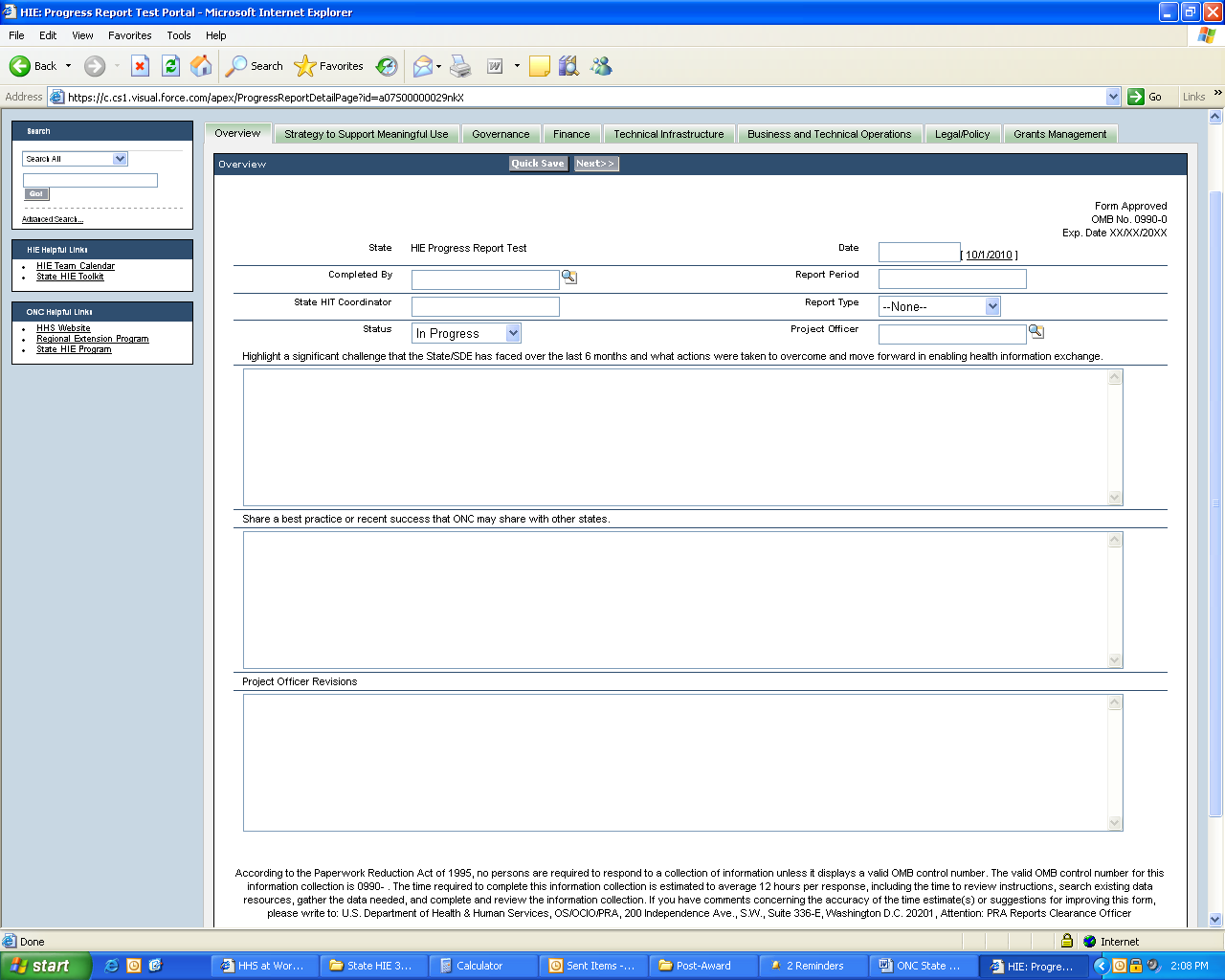
(scrolled to bottom of screen)
Strategy to Support Meaningful Use Module
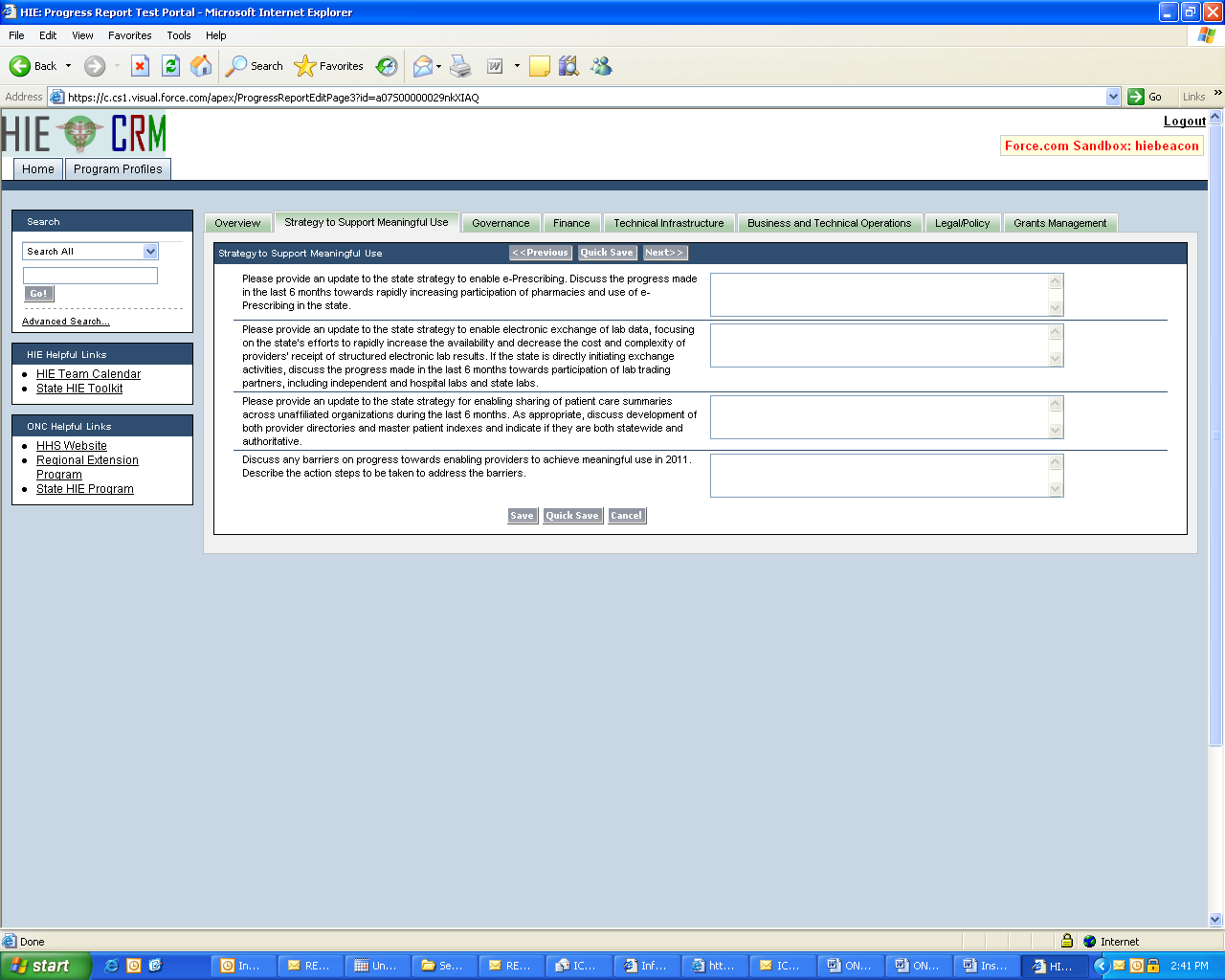
Governance Module
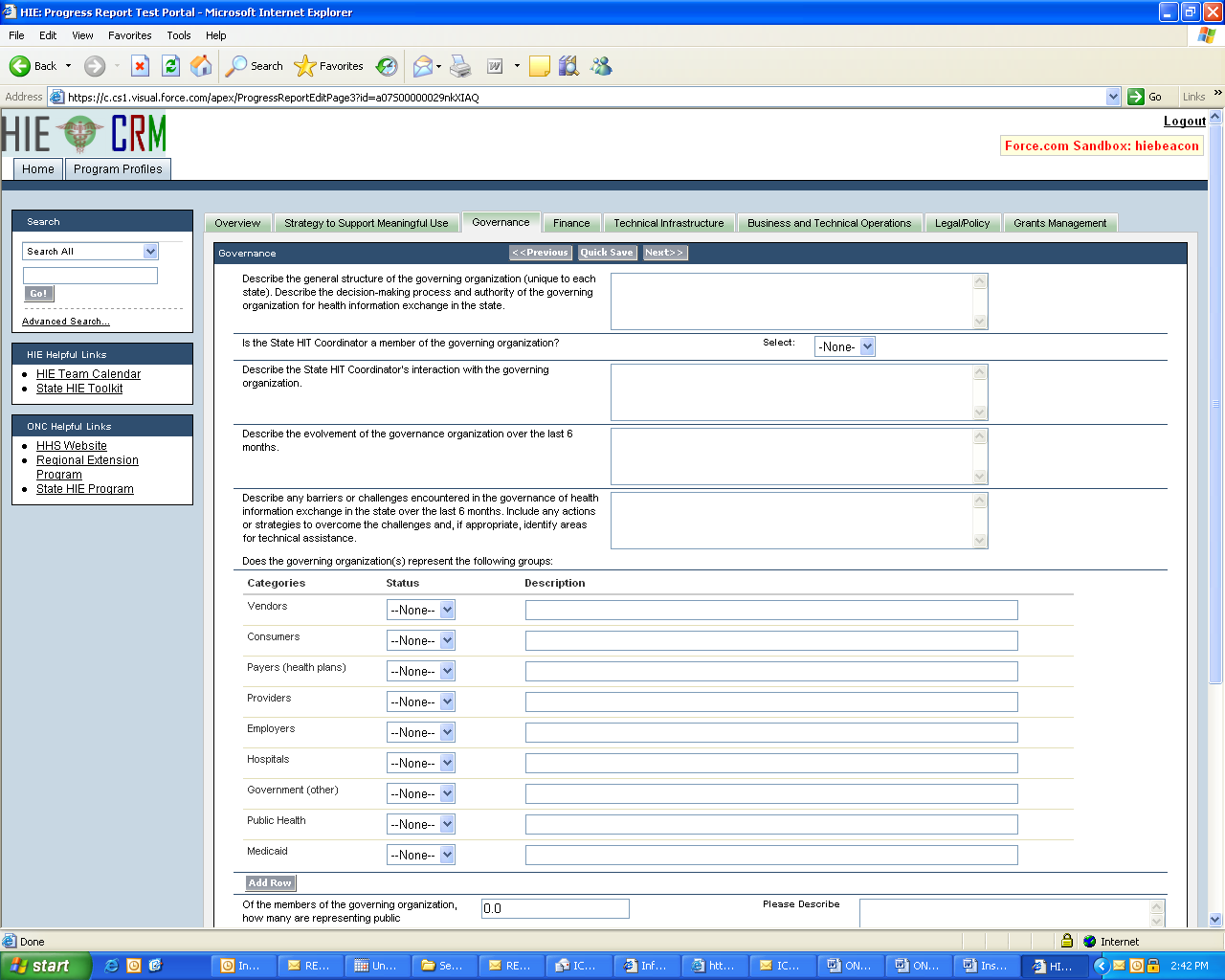
Finance Module
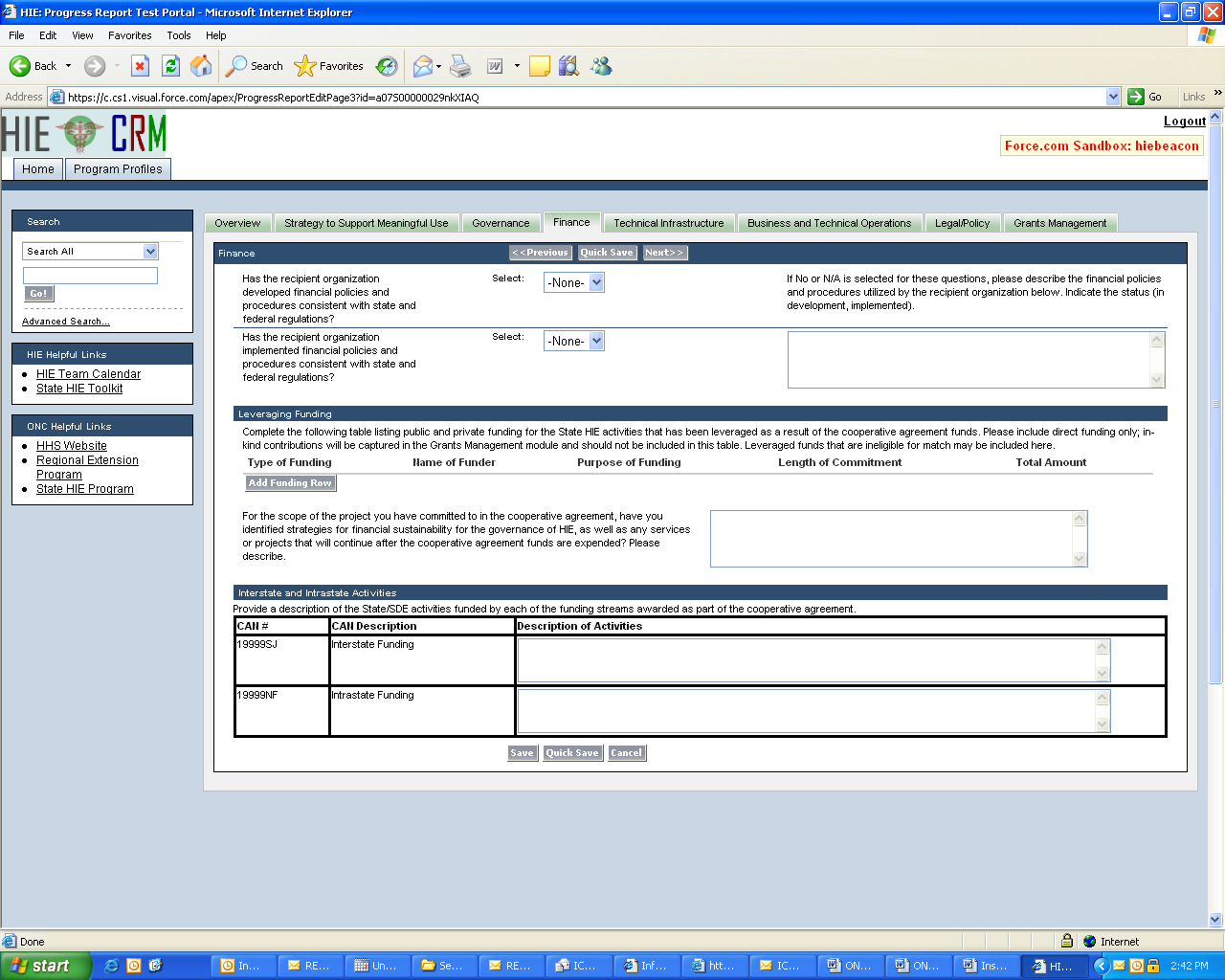
Technical Infrastructure Module
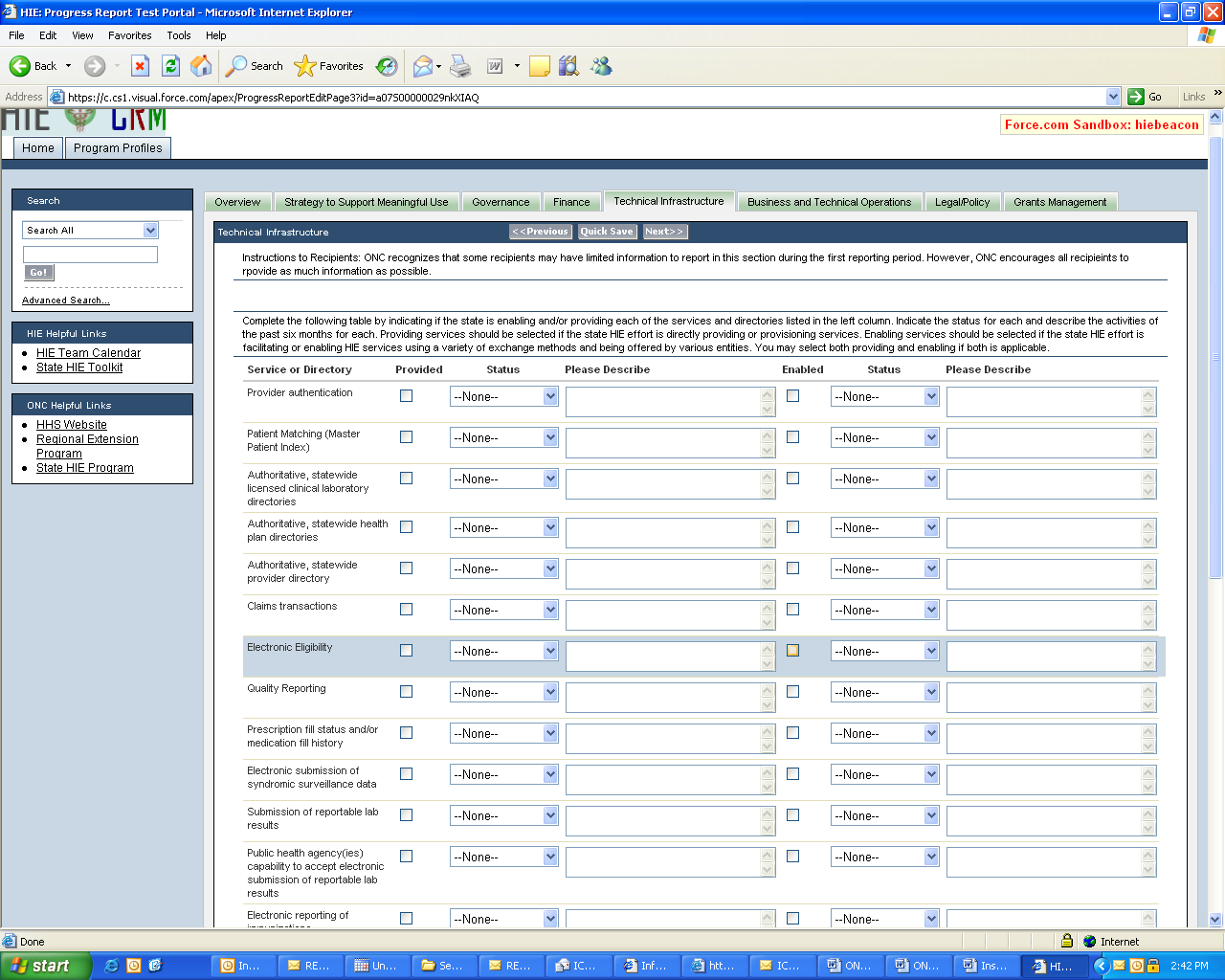
Business and Technical Operations Module
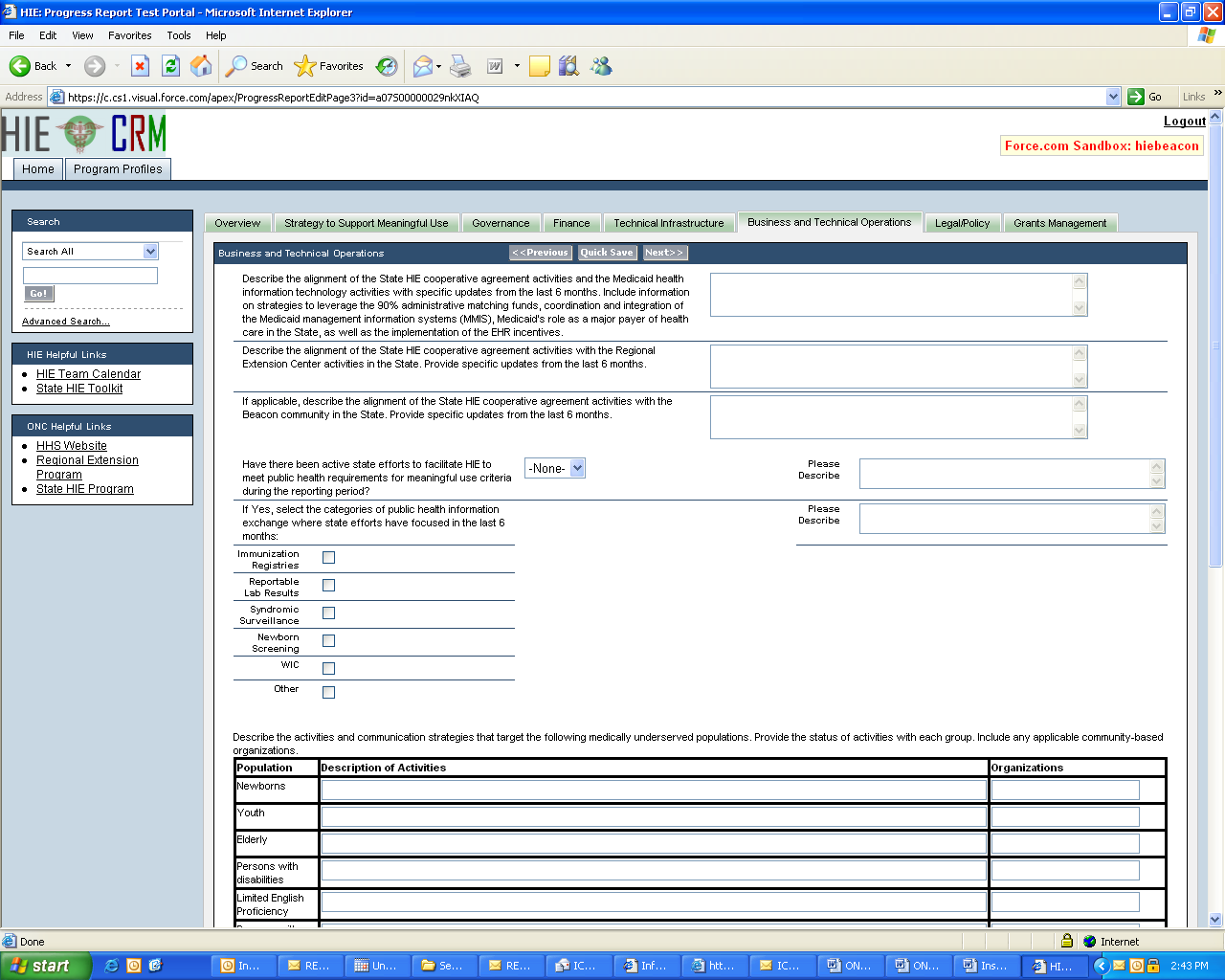
Legal/Policy Module
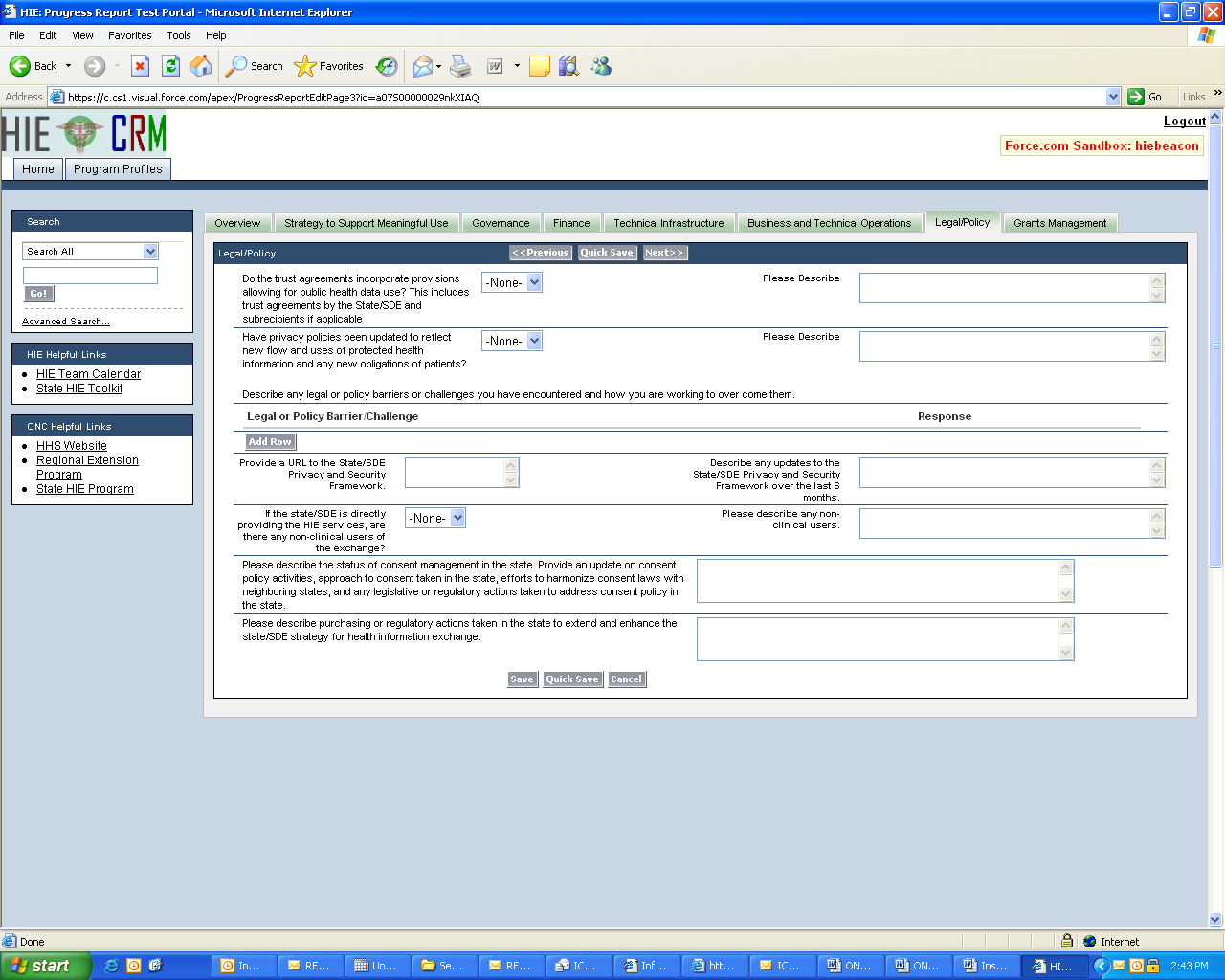
Grants Management Module

Attachment 6
See attachment: Instructions for Completing the Program Progress Report
| File Type | application/msword |
| File Title | How to Write and Submit |
| Author | CMS |
| Last Modified By | DHHS |
| File Modified | 2010-11-09 |
| File Created | 2010-11-09 |
© 2025 OMB.report | Privacy Policy